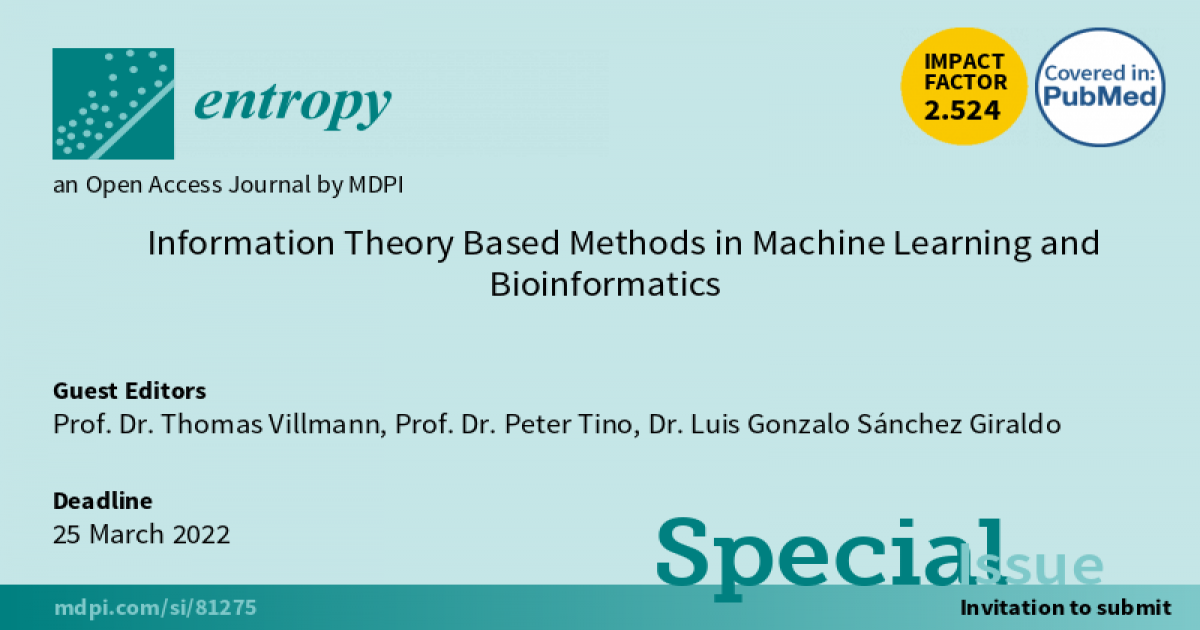Information Theory Based Methods in Machine Learning and Bioinformatics
A special issue of Entropy (ISSN 1099-4300). This special issue belongs to the section "Signal and Data Analysis".
Deadline for manuscript submissions: closed (25 March 2022) | Viewed by 8227

Special Issue Editors
Interests: machine learning; computational intelligence; interpretable models; information theory; pattern recognition; learning vector quantization; bioinformatics
Interests: theory and interdisciplinary applications of machine learning; probabilistic modeling and dynamical systems
Interests: machine learning for signal processing; information theoretic learning; representation learning; computer vision; computational neuroscience
Special Issues, Collections and Topics in MDPI journals
Special Issue Information
Dear Colleagues,
Information theoretic methods constitute a universal principle in science. In machine learning, such principles stimulate new concepts and can justify existing heuristic approaches, as well as giving new insights into established theories. Many machine learning problems, such as clustering, classification, dimensionality reduction and metric learning, have been framed in the context of information theory. In particular, in bioinformatics, information theoretic approaches in machine learning provide principles and paradigms for efficient information extraction and processing, which constitute modern statistical tools for advanced genomics, proteomics, structure analytics, etc.
The aim of this Special Issue is to collect recent results on information theory-related machine learning methods in bioinformatics. We also invite submissions about new perspectives, currently ongoing research, and discussions regarding existing approaches. As such, the papers can either provide theoretical perspectives, highlight outstanding applications, or introduce new perspectives and concepts in bioinformatics. Review papers dedicated to specific aspects of information theoretic learning in biomedical contexts are also welcome.
In the filed of bioinformatics, we emphasize topics such as sequence analysis using information theoretic machine learning methods, applications in molecular biology, structure analysis, as well as applications in biomedicine. These topics are not exclusive; papers addressing other bioinformatic topics related to information theoretic methods in machine learning will be considered as well.
Prof. Dr. Thomas Villmann
Prof. Dr. Peter Tino
Dr. Luis Gonzalo Sánchez Giraldo
Guest Editors
Manuscript Submission Information
Manuscripts should be submitted online at www.mdpi.com by registering and logging in to this website. Once you are registered, click here to go to the submission form. Manuscripts can be submitted until the deadline. All submissions that pass pre-check are peer-reviewed. Accepted papers will be published continuously in the journal (as soon as accepted) and will be listed together on the special issue website. Research articles, review articles as well as short communications are invited. For planned papers, a title and short abstract (about 100 words) can be sent to the Editorial Office for announcement on this website.
Submitted manuscripts should not have been published previously, nor be under consideration for publication elsewhere (except conference proceedings papers). All manuscripts are thoroughly refereed through a single-blind peer-review process. A guide for authors and other relevant information for submission of manuscripts is available on the Instructions for Authors page. Entropy is an international peer-reviewed open access monthly journal published by MDPI.
Please visit the Instructions for Authors page before submitting a manuscript. The Article Processing Charge (APC) for publication in this open access journal is 2600 CHF (Swiss Francs). Submitted papers should be well formatted and use good English. Authors may use MDPI's English editing service prior to publication or during author revisions.








